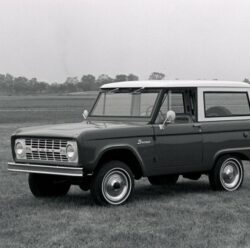Bronco is Back! What the Ford Bronco Has Meant to the Car Industry Over the Years
The Ford Bronco has been a motoring icon for generations. Sleek, affordable, capable on and off road, it is no secret why this vehicle captured the hearts of so many. Now, with the 2021 Bronco Sport already on the roads and the more traditional 2021 Bronco rolling off the production lines this summer, it’s a great time to revisit the history of such an industry classic.
First Generation (1966-1977)
Along with the Mustang, Donald N. Frey designed one of the world’s first SUVs, the Ford Bronco. Three body types were available for purchase including a two-door wagon, half-cab pickup, and an open-body roadster. The design was meant to compete with the Jeep CJ and the International Harvester Scout, and compete it did. In the first year alone, the Bronco sold over 24,000 vehicles.
Second Generation (1978-1979)
By the time the second generation Bronco came around, it had become a staple of American car culture. Twelve years had passed since the release of the first generation, and the redesign was major. The vehicle was bigger with more leg room and a larger cargo area. The three separate models from years past were condensed down to one three-door model that came with a removable hardtop. The future fan-favorite removable back window was also added. The second generation Bronco was so popular that many customers had to wait up to six months to get one from their local Ford dealer.
Third Generation (1980-1986)
The dawn of the 80’s was met with rising gas prices and smaller Ford Broncos. The third generation of Bronco was shorter, lighter, more aerodynamic, and more fuel efficient. A complement to this design was the new inclusion of a V-6 option instead of the standard V-8. This generation also saw the birth of the Bronco II; introduced in 1983, it was seen as a more road-focused Bronco, later being replaced by the Ford Explorer in 1990.
Fourth Generation (1987-1991)
The fourth generation Bronco saw the classic 4×4 brought into the modern age. This included the introduction of electronic fuel injection, rear anti-lock brakes, a new 5-speed transmission, and the option of leather seats. These and various other upgrades allowed the fourth gen to be the first Bronco capable of 100 mph.
Fifth Generation (1992-1996)
With minimal body changes, the fifth generation Bronco can be easy to overlook. What makes this Bronco special are the things you can’t see. Ford named this generation the “Smartest Bronco Ever” due to the addition of many new features, including diver side airbags, three-point seat belt systems, and an upgraded air-conditioning unit. Although this was the most advanced Bronco yet, it was still the last generation. The final Bronco rolled off the assembly line on June 12, 1996, putting an end to the 30 year run of the classic SUV.
The New Bronco (2021)
Ford surprised everybody by announcing the return of the Bronco in early 2020. It was shocking to hear the Bronco name for the first time in 24 years, but at the same time made all the sense in the world. With the ever-increasing SUV market, why wouldn’t Ford bring back one of its bestselling SUV’s of all time? The new Bronco is available in two body styles – the Ford Bronco Sport, a smaller family oriented crossover, and the more traditional Ford Bronco, available in both two and four doors.
Having worked with dealerships since 1927, Reynolds has been helping sell the Bronco since the beginning and we are more than excited to see the iconic SUV’s return! To learn more about Reynolds and how we help car dealerships, visit https://www.reyrey.com/company/careers/our-company

















